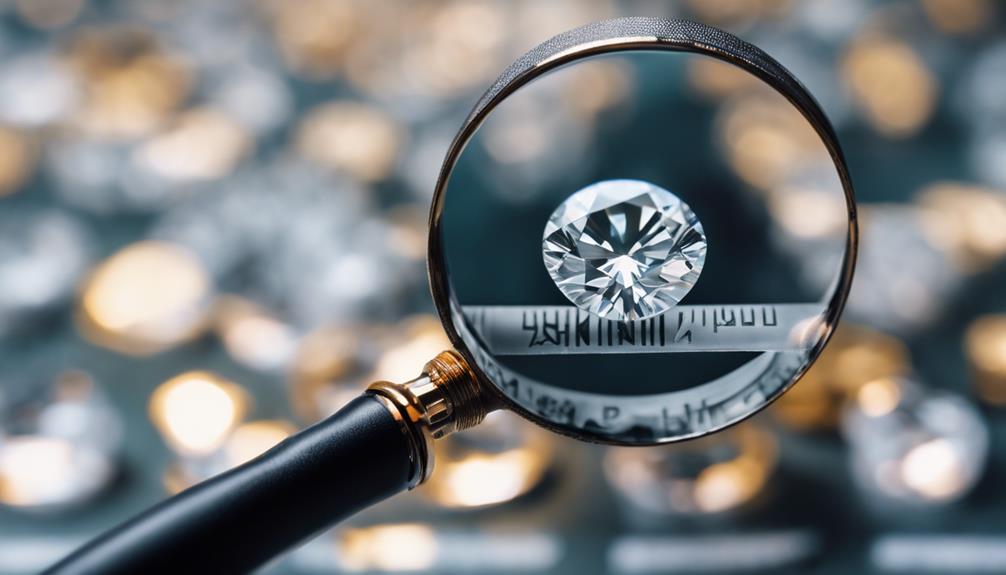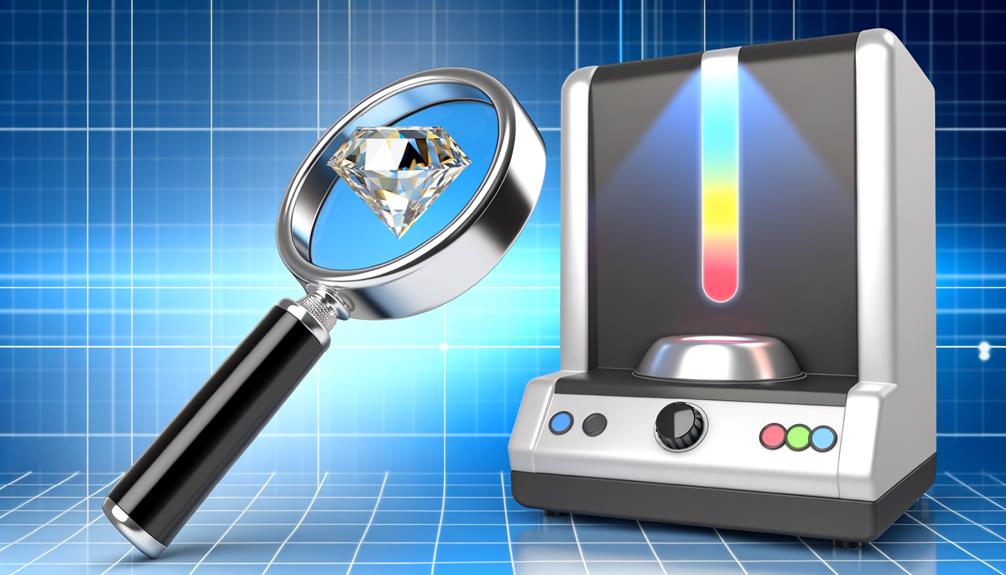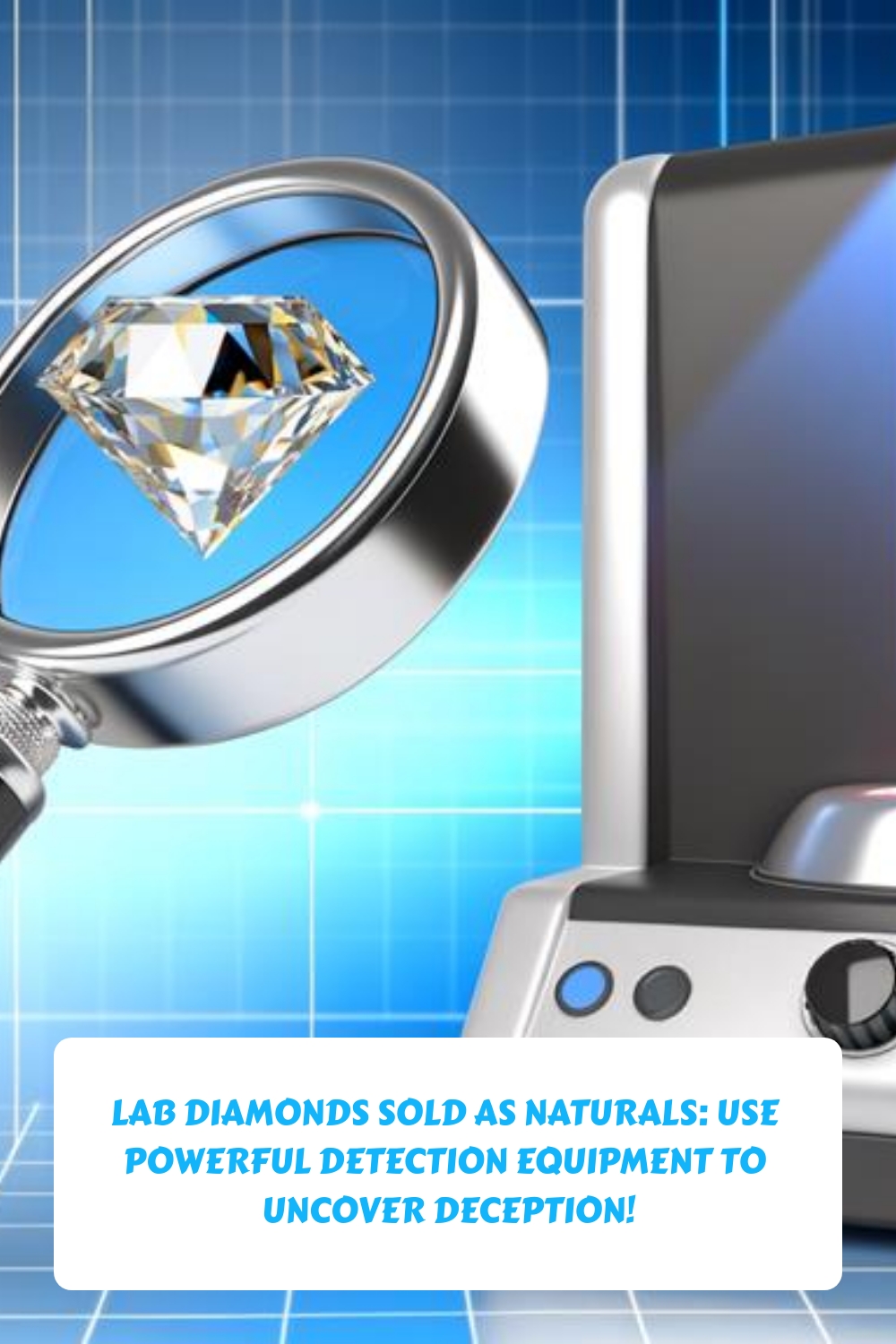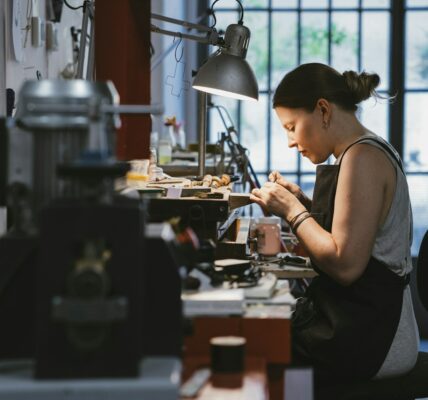Lab Diamonds Sold as Naturals: Use Powerful Detection Equipment to Uncover Deception!
Detecting lab-grown diamonds masquerading as natural ones presents a significant challenge in the jewellery industry. Advanced detection equipment plays a crucial role in upholding trust and integrity within the sector. These sophisticated tools are designed to navigate modern jewellery settings’ complexities, requiring precise operation and comprehensive training to ensure accurate results.
Techniques such as spectroscopy and advanced imaging are instrumental in distinguishing between synthetic and natural diamonds, addressing trust, reputation, and regulatory compliance concerns. With the increasing demand for sustainable and ethical options, ongoing innovation in detection technology is essential. The industry’s credibility relies on accurately identifying diamonds to maintain consumer confidence and adherence to legal standards.
Exploring these detection methods further underscores their vital importance in the industry.
Article Contents
- 1 Key Takeaways About Lab Diamonds Sold as Naturals
- 2 Detection Challenges
- 3 Essential Tools
- 4 Detection Techniques
- 5 Industry Impact
- 6 Trends and Challenges
- 7 Testing Practices
- 8 Regulations Compliance
- 9 Frequently Asked Questions
- 9.1 How Do Environmental and Ethical Concerns Impact Consumer Preferences Between Lab-Grown and Natural Diamonds?
- 9.2 What Are the Long-Term Financial Implications for Retailers and Consumers When Investing in Lab-Grown Diamonds Versus Natural Diamonds?
- 9.3 How Do Advancements in Lab-Grown Diamond Technology Challenge Current Detection Methods, and What Future Innovations Are Anticipated to Improve Detection?
- 9.4 Can Lab-Grown Diamonds Obtain the Same Certification as Natural Diamonds, and How Does This Affect Their Market Value?
- 9.5 How Does the Resale Value of Lab-Grown Diamonds Compare to That of Natural Diamonds, and What Factors Influence This?
- 10 Lab Diamonds Sold as Naturals: A Problem with a Solution
- 11 Further Reading About Lab Diamonds Sold as Naturals
Key Takeaways About Lab Diamonds Sold as Naturals
- Sophisticated detection equipment plays a vital role in distinguishing lab-grown diamonds that are being presented as natural diamonds.
- Tools such as spectroscopy and advanced imaging techniques are essential for accurately differentiating between synthetic and natural diamonds.
- The training of operators in using detection equipment significantly impacts the accuracy of identifying undisclosed lab-grown diamonds.
- Adhering to industry guidelines and testing protocols is crucial to maintaining the integrity of the diamond verification process.
- Continuous innovation in detection technology is necessary to address the evolving challenges of distinguishing lab-grown diamonds from natural ones.
Detection Challenges
Detecting lab-grown diamonds masquerading as natural ones poses significant challenges, especially when examining jewellery adorned with multiple small stones or intricate settings like micro-pavé. Despite advancements in screening techniques, the task remains daunting, particularly when faced with hidden diamonds within elaborate designs. Differentiating synthetic diamonds from natural ones requires meticulous scrutiny due to their close visual resemblance but distinct origins and values.
Jewellery evaluation becomes even more complex when pieces feature clusters of small diamonds commonly found in contemporary designs. This complicates the isolation and examination of each stone. The presence of concealed diamonds, such as those nestled within the inner recesses of a ring or concealed behind ornamental details, adds another layer of difficulty to the inspection process. Traditional screening methods may not always suffice in such scenarios, demanding a deep understanding of the physical and optical characteristics that set lab-grown diamonds apart from their natural counterparts.
These factors underscore the need for advanced screening methods and a comprehensive approach to identifying synthetic diamonds, safeguarding the transparency of the diamond industry and fostering consumer confidence.
Essential Tools
In the realm of diamond detection, having the right tools is essential for accurate identification, especially when it comes to distinguishing between natural and lab-grown diamonds. The reliability of the equipment is paramount, as it must consistently provide precise results. This reliability not only upholds the integrity of the diamond market but also fosters consumer trust by ensuring accurate identification. There are now about 40 pieces of equipment that can accurately distinguish between lab and natural diamonds.
Operator training is equally crucial in this process. Even with advanced equipment, the operator’s expertise significantly impacts the identification of synthetic diamonds. Well-trained personnel can enhance detection efficiency, streamline the process, and reduce errors.
The market implications are significant. Accurate identification of lab-grown diamonds helps maintain the value of natural diamonds and prevents market dilution from undisclosed synthetics. Protecting consumer interests and industry standards creates a transparent and trustworthy market environment.
Detection efficiency is key. The ability to swiftly and accurately screen diamonds for synthetic attributes enables effective quality control measures. This efficiency saves time and reduces the risk of mistakenly selling lab-grown diamonds as natural, preserving the credibility and trustworthiness of diamond retailers and suppliers.
Detection Techniques
The focus of modern detection technologies is on identifying synthetic diamonds, whether they are loose stones or already set in jewellery. With intricate jewellery designs featuring micro-pavé settings or concealed halos, a thorough examination is essential to prevent misidentifications. Gemstone verification often requires the use of multiple tools and skilled operators to achieve precise results.
The key to these detection efforts lies in using specific instruments tailored for the task, including spectroscopy, fluorescence detection, and advanced imaging techniques. These tools not only aid in identifying lab-grown diamonds but also streamline the screening procedures. By leveraging these advanced technologies, the industry aims to uphold trust and transparency, ensuring that consumers receive accurate information about the diamonds they intend to purchase.
Industry Impact
The discovery of undisclosed lab-grown diamonds has significant implications for the jewellery industry, impacting trust, reputation, and compliance with legal standards. Consumer trust, a cornerstone of the industry’s success, is especially at risk. When consumers buy diamonds, they invest emotionally and financially, expecting authenticity and transparency. The presence of undisclosed lab-grown diamonds in the market without proper labelling undermines this trust, creating serious reputational risks for jewellers. These consequences can extend beyond individual businesses, potentially damaging the industry’s overall image.
To mitigate these risks, industry players must be vigilant. Retailers, manufacturers, and dealers are increasingly required to implement thorough screening practices. These measures are crucial not only for protecting the integrity of their inventory but also for ensuring compliance with legal requirements. Regulations, such as those enforced by the Federal Trade Commission (FTC), require the clear disclosure of a diamond’s lab-grown origin. Non-compliance can lead to legal consequences, highlighting the importance of detailed and regular testing.
Trends and Challenges
The diamond industry is experiencing a shift in consumer preferences towards non-traditional diamond shapes and ethical considerations, presenting both new trends and challenges. There is a growing demand for ethically sourced and environmentally friendly options, including lab-grown diamonds, leading to a focus on transparency and sustainability within the market. However, this shift poses gemological challenges, especially in accurately differentiating between lab-grown and natural diamonds without proper disclosure.
The presence of undisclosed lab-grown diamonds in the market highlights the risks associated with synthetic diamonds, emphasizing the need for advanced detection techniques. Industry professionals are actively working to enhance detection capabilities and educate stakeholders on the importance of ethical practices. Despite these efforts, challenges persist due to technological advancements enabling lab-grown diamonds to resemble natural diamonds closely. Continuous innovation and vigilance are necessary to maintain consumer trust and uphold the integrity of natural diamonds as the market evolves. The evolution of diamonds in the market, with the introduction of lab-grown diamonds, requires a proactive approach to ensure transparency and ethical sourcing. Advancements in detection techniques and collaboration within the industry will be essential to address the evolving landscape of diamond production. Maintaining consumer trust and upholding the value of natural diamonds amidst this evolution will be an ongoing challenge that the industry must continue to address.
The diamond industry must navigate these complex dynamics to meet consumer demands while effectively managing the risks associated with synthetic diamonds.
Testing Practices
Effective diamond testing practices are essential for distinguishing between lab-grown and natural diamonds, maintaining consumer trust and upholding industry integrity. Advanced technology significantly enhances testing accuracy, enabling the precise identification of lab-created diamonds. Reliable equipment is a cornerstone of effective diamond verification, ensuring consistent results across multiple tests.
Instrument testing, which involves tools like microscopes, polariscopes, and specialized spectroscopy equipment, has become standard in the industry. These instruments leverage cutting-edge technology to examine the intricate details of diamonds, identifying unique characteristics that differentiate lab-grown stones from natural ones. The accuracy of these testing methods is crucial, as it directly impacts the credibility of the verification process.
Furthermore, the evolution of diamond verification equipment has improved the efficiency of testing practices. High-quality, dependable instruments can quickly analyze a wide range of diamond samples, reducing the time needed for verification without compromising accuracy. This efficiency is particularly beneficial for businesses handling large volumes of diamonds, allowing them to maintain the integrity of their products and uphold consumer confidence.
Regulations Compliance

Ensuring compliance with regulations is vital for retailers and manufacturers in the diamond industry to avoid legal issues and maintain trust with consumers. Following regulatory requirements is more than just obeying laws; it’s about guaranteeing that every diamond sold meets the specified authenticity standards. According to industry standards and testing protocols, this entails using detection equipment with the highest levels of accuracy.
Additionally, regulatory standards often require companies to keep records of their testing results, showcasing their dedication to compliance and transparency. This helps build consumer confidence and safeguards businesses from potential legal issues related to undisclosed lab-grown diamonds. The diamond industry strives to uphold its integrity and maintain consumers’ trust worldwide through strict adherence to testing protocols and industry guidelines.
Frequently Asked Questions
How Do Environmental and Ethical Concerns Impact Consumer Preferences Between Lab-Grown and Natural Diamonds?
Environmental and ethical concerns play a significant role in shaping consumer preferences between lab-grown and natural diamonds. Increasingly, consumers are prioritizing sustainability practices and ethical sourcing due to a heightened awareness of the environmental impact and social responsibilities associated with traditional diamond mining.
This shift in consumer mindset is driving a surge in interest in lab-grown diamonds, which are viewed as more eco-friendly and ethically sound alternatives. It reflects a deeper level of consumer engagement with the origins and production practices behind their purchases, highlighting the importance of considering the environmental and ethical implications of diamond choices.
What Are the Long-Term Financial Implications for Retailers and Consumers When Investing in Lab-Grown Diamonds Versus Natural Diamonds?
When deciding between investing in lab-grown diamonds or natural diamonds, it’s important to consider the long-term financial implications. Lab-grown diamonds often have lower initial costs and come with warranty offers, making them attractive to budget-conscious consumers. However, market saturation may make their resale value and market demand less stable.
On the other hand, natural diamonds tend to hold their value better over time, appealing to long-term investors.
Retailers and consumers need to weigh these factors carefully when making a decision. While lab-grown diamonds may offer immediate savings, there is a risk of fluctuating resale value. Natural diamonds, while pricier upfront, may provide more stability regarding value retention. It’s essential to consider both the short-term costs and potential future market shifts when choosing between lab-grown and natural diamonds for investment purposes.
How Do Advancements in Lab-Grown Diamond Technology Challenge Current Detection Methods, and What Future Innovations Are Anticipated to Improve Detection?
Advancements in lab-grown diamond technology present challenges to current detection methods, leading to the need for more advanced detection technologies. These advancements encompass improvements in spectroscopy, material analysis, and the recognition of synthetic fingerprints, which are crucial for preventing fraud.
Future innovations are expected to enhance the precision and effectiveness of detection, ensuring a clear and reliable differentiation between lab-grown and natural diamonds. This development is essential for maintaining consumer trust and upholding the industry’s integrity.
Can Lab-Grown Diamonds Obtain the Same Certification as Natural Diamonds, and How Does This Affect Their Market Value?
Lab-grown diamonds have the ability to attain certifications similar to natural diamonds through adherence to established grading standards. This achievement and strategic marketing approaches boost their market value and increase consumer awareness. One such certification that lab-grown diamonds can obtain is the SCS 007 Diamond Certification, which verifies their authenticity and quality. By meeting the requirements for this certification, lab-grown diamonds can demonstrate their commitment to ethical and sustainable practices, further enhancing their appeal to environmentally conscious consumers. This certification also provides assurance to buyers that they are investing in a genuine and high-quality product, ultimately contributing to the continued growth of the lab-grown diamond market.
However, adherence to trade regulations requires transparent disclosure to ensure customers are fully informed about their purchase. This transparency plays a crucial role in maintaining trust within the diamond industry and preserving the integrity of market transactions.
How Does the Resale Value of Lab-Grown Diamonds Compare to That of Natural Diamonds, and What Factors Influence This?
The resale value of lab-grown diamonds tends to be lower than that of natural diamonds. Diamond liquidity, investment stability, perceptions of rarity, market saturation, and consumer awareness are the main factors influencing this difference.
Natural diamonds hold their value better over time due to their scarcity and long-standing presence in the market. In contrast, despite being visually and chemically identical to natural diamonds, lab-grown diamonds can lose value because of their replicability and the continuous advancements in production methods.
These factors contribute to market saturation and affect how consumers perceive the value of lab-grown diamonds compared to their natural counterparts.
Lab Diamonds Sold as Naturals: A Problem with a Solution
A sophisticated approach is essential in detecting lab-grown diamonds masquerading as natural, combining advanced equipment and expert skills.
Using state-of-the-art technologies like Raman spectroscopy, in conjunction with traditional gemological testing, is crucial in upholding the integrity of the gemstone industry.
Times are changing in the diamond detection space. In a Rapaport article, Guy Borenstein, the director of gemstone procurement for the Lafayette, Louisiana-based manufacturer, Stuller Inc., said:
Guy Borenstein, Stuller Inc.
“Five years ago, I asked attendees how many were screening for lab-grown diamonds [LGDs] and one hand went up,” That number has grown as the years passed, but “the majority are still not checking,” he added.
Clearly, there is still a long way to go, and all levels in the diamond supply chain need to up their game to protect themselves and their clients from costly mistakes.
As lab-grown diamond technology advances, detection methods must evolve to preserve consumer trust and the value of genuine diamonds.
Further Reading About Lab Diamonds Sold as Naturals
1: Can Lab-Grown Diamonds be Detected
2: Detecting Lab-Grown Diamonds That Deceive
3: Can A Jeweler Detect Lab-Grown Diamonds – An In-depth Analysis
4: GIA Device Identifies Lab-Grown Diamonds Within Seconds
5: New Technology Allows Lab-grown Diamonds to be Identified From Natural Ones






